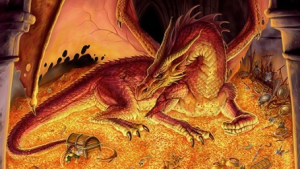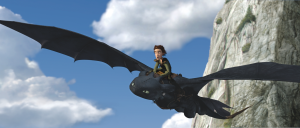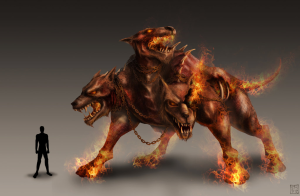What kinds of magical creatures should populate your fantasy world? Well, that’s a decision you’ll have to make for yourself, but there are three basic categories you can use. First, there are types of magical creatures that a reader is already familiar with (e.g. fire-breathing dragons, unicorns, etc). Second, there are types that the reader may be slightly familiar with but that an author has imbued with distinctive characteristics (e.g. the basilisk in Harry Potter). Third, there are types that have never been seen before (e.g. fire spiders in The Quest of the Unaligned, or chulls and axehounds in Brandon Sanderson’s Stormlight Archive). Each type comes with its own advantages and disadvantages for fantasy authors who want to use them.
Standard magical creatures
 The major advantage of using types of creatures that readers already know about is that, well, readers already know about them. You can make a passing reference to a town being laid waste by a dragon, and readers fill in the gaps: a fire-breathing winged lizard, likely with an inordinate desire for gold and a heated temper, flew out of his cave in the mountains and burned down the village. Just like you don’t have to tell readers that kings outrank peasants, or that bread is a food, you don’t have to tell them that dragons are dangerous and likely only able to be bested by a hero (or your protagonist). If the point of your story is its characters and their interaction rather than its worldbuilding, if the creatures in question are not vital to the plot, or if your story is set in a version of our own world where legends are true (e.g. Harry Potter), then including standard magical characters in a plot can give your story a fun twist, without too much work on an author’s part.
The major advantage of using types of creatures that readers already know about is that, well, readers already know about them. You can make a passing reference to a town being laid waste by a dragon, and readers fill in the gaps: a fire-breathing winged lizard, likely with an inordinate desire for gold and a heated temper, flew out of his cave in the mountains and burned down the village. Just like you don’t have to tell readers that kings outrank peasants, or that bread is a food, you don’t have to tell them that dragons are dangerous and likely only able to be bested by a hero (or your protagonist). If the point of your story is its characters and their interaction rather than its worldbuilding, if the creatures in question are not vital to the plot, or if your story is set in a version of our own world where legends are true (e.g. Harry Potter), then including standard magical characters in a plot can give your story a fun twist, without too much work on an author’s part.
The problem with using standard magical characters is that it can make a story feel derivative. There are only so many ways to slay a dragon, and they’ve all been written countless times. That doesn’t mean you can’t have a fresh take on dragon-slaying, but it does meant that you have to work harder to show readers why your story is different. Similarly, if you are focusing on building a magical world that is very different from Earth and its classic mythologies, it can be jarring to readers to have creatures show up that have no logical reason to be there. Finally, once you start importing magical creatures from a given culture, you are almost making an agreement with a reader to stay within given cultural guidelines for the rest of the story. Having leprechauns (Irish myth), sirens (Greek myth), and kitsune (Japanese myth) all running around in the same world, for instance, would seem strange, if not even wrong to reader sensibilities.
Adapted magical characters
 In this category lie all creatures that are trope subversions, spin-offs, inspirations, or even just distant cousins of their more standard magical counterparts. These creatures all have the same name as commonly known magical critters (e.g. dragons), but they are different in either a minor or a major way from what readers expect. One great example in print is Patricia C. Wrede’s Dealing With Dragons series, in which readers learn that dragons are honorable creatures who enjoy cherries jubilee, choose their own king, and are in a constant struggle against a society of wizards whose staffs can absorb dragons’ magic. The advantage of using this category is that authors can surprise and intrigue readers who are looking for something “familiar yet different.”
In this category lie all creatures that are trope subversions, spin-offs, inspirations, or even just distant cousins of their more standard magical counterparts. These creatures all have the same name as commonly known magical critters (e.g. dragons), but they are different in either a minor or a major way from what readers expect. One great example in print is Patricia C. Wrede’s Dealing With Dragons series, in which readers learn that dragons are honorable creatures who enjoy cherries jubilee, choose their own king, and are in a constant struggle against a society of wizards whose staffs can absorb dragons’ magic. The advantage of using this category is that authors can surprise and intrigue readers who are looking for something “familiar yet different.”
The disadvantage of using adapted magical characters is that readers can get confused or even irritated if an author changes too many things that are traditionally part of that character’s makeup. Major physical characteristics are typically the last to be changed – a centaur, for instance, must be half-horse and half-man to be considered a centaur. Traditionally, they are seen as wise, mysterious prophets and/or astrologers. But in Gail Carson Levine’s Ella Enchanted, centaurs don’t even have human intelligence, much less exceptional wisdom. Instead, they are kept in zoos and are fed apples by human visitors. Are these “real” centaurs? Should the author have written them this way? As a more extreme example, suppose that an author writes about creatures called “goblins” who are small and ugly in appearance (a traditional goblin description), but live in trees, eat berries and nuts, spend their days playing music and dancing, and are kind and generous to all who can look past their external appearance. Are these actually goblins? If an author is writing about a race like this, it might actually do the reader a disservice to give the creature a name that will bring to mind a large number of attributes that will be inaccurate. Instead, this brings us to the third category…
Original magical characters
Now, to start off, we should note that simply calling an already established magical species by a different name does not make it an original character. If you have a fire-breathing lizard with scales hard as diamonds that loves gold and has a mean streak, please just call it a dragon, a wurm, a wyvern, or whatever your myth-based name of choice is. But don’t call it a Snarglax or a Death-Lizard just because you want to avoid having “dragons” in your book. Your readers will see through you in a second, and they won’t approve.
 Good original magical characters might combine two (or more!) creatures that actually exist on Earth (e.g. flying horses/monkeys), give more or different powers to a creature that actually exists (e.g. horses with human-level intellect, vultures that spit lightning, or octopuses with mind control powers), make a creature abnormally large or small (e.g. Shelob the giant spider), make significant physical changes to a real creature (e.g. a two-headed dog or an alligator with a dorsal fin and six legs), combine some features previously mentioned, or actually just make a creature up. Even made-up creatures, however, are typically modeled after real-life physiology to a certain extent, if just to give readers enough mental cues to be able to picture the creature you’re describing. The good thing about this category of creatures is its uniqueness. An author can use original characters to add breadth, depth, and a sense of wonder to a story. They raise new possible puzzle solutions, plot twists, and reasons for characters to interact in different ways. They keep the reader guessing and enthralled in the world an author has created.
Good original magical characters might combine two (or more!) creatures that actually exist on Earth (e.g. flying horses/monkeys), give more or different powers to a creature that actually exists (e.g. horses with human-level intellect, vultures that spit lightning, or octopuses with mind control powers), make a creature abnormally large or small (e.g. Shelob the giant spider), make significant physical changes to a real creature (e.g. a two-headed dog or an alligator with a dorsal fin and six legs), combine some features previously mentioned, or actually just make a creature up. Even made-up creatures, however, are typically modeled after real-life physiology to a certain extent, if just to give readers enough mental cues to be able to picture the creature you’re describing. The good thing about this category of creatures is its uniqueness. An author can use original characters to add breadth, depth, and a sense of wonder to a story. They raise new possible puzzle solutions, plot twists, and reasons for characters to interact in different ways. They keep the reader guessing and enthralled in the world an author has created.
What’s the downside, then? First, it takes a lot of work for an author to create realistic original magical characters that make sense in a world. Second, it can be a lot of work for readers to interact with a world that incorporate original magical characters. The more new things readers have to carry around in their heads, the more likely they’ll be to get confused and forget some of them.
So what type of magical creature should you put in your world? Now that you know your options, it’s up to you!